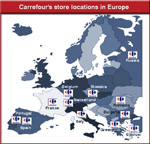|
Page
4 of 4
"They made a wrong move because
they killed their own tool by stupidity."
The reason behind the company's nonchalant
attitude towards lower operating costs,
he said, was because the company's turnover
each year was so great that management was
not looking to monitor expenses more closely.
On a brighter note, the concept behind
Carrefour's China sourcing success still
exists. Other big retailers jumped on the
bandwagon after Carrefour's success, but
many failed to implement the concept and
gave up trying.
One of the main stumbling blocks was
the lowering the operational expense. One
of the first and perhaps greatest hurdles
in achieving this was getting the factory
to lower its prices. A supplier can't handle
other factories' goods; hence the logistics
firm acts as a go-between to provide value-added
services.
Basing the operation within a free trade
zone created problems in itself because
of the many restrictions. For example, whatever
entered must be shipped out, but what happens
when the goods had defects or the order
was cancelled?
With a non-Customs bonded warehouse,
there is greater flexibility to manage the
inventory with the vendors and the deliveries,
it is not necessary to issue an invoice
for Customs at every delivery.
Goods can also be inspected at the warehouse
for defects and faulty goods can be returned
to the factory and replaced without having
to do extra paperwork.
There is a lot of paperwork involved
in returning goods from a bonded warehouse
and, "at the end of the day you want
to receive the goods, pack it and ship it.
You don't want to waste your time with extra
paperwork and of course it adds cost to
everyone."
In north China, there were very few Customs
supervised warehouses or bonded warehouses.
The trend therefore was to use a common
warehouse, whereas in south China the situation
was the opposite. New big warehouses were,
for example, being developed about five
to eight kilometres from the Nansha international
container terminal.
 click image
to enlarge click image
to enlarge
There was a barge system connecting this
southern China deepwater port to Hong Kong,
which was cheaper than trucking the cargo
to Hong Kong or Shekou and Yantian, and
more convenient for west Pearl River Delta
factories.
However, using a Customs supervised warehouse
or free trade zone did not imply the vendor
would receive his tax refund immediately.
He would generally receive the tax refund
when the funds from overseas had been received.
(In China overseas retailers have up to
90 days to settle the bill).
If a vendor delivered goods today to
the warehouse in principal he would receive
his paper for the tax refund. However, this
certificate could not be used straight away.
Only after the vendor had received the
tax refund together with the foreign exchange
certificate for the money from overseas
could he go to the Tax Bureau for his refund.
Shipping managers were generally not aware
of this and neither were a lot of the big
global sourcing companies as they did not
know much about trading in China, considering
it "a big, complicated web."
It was important for retailers to understand
that this method of supply chain management
exists as it could have created a truly
significant cost saving, a major advantage
for companies in any day and age.
Greater efficiency and lower overhead
costs are the most important factors for
the modern globalised retailer. The service
provider who can open these possibilities
for his customer will certainly stand out
in the market.
Page 1 2
3 4
|